ASRock Rack C2750D4I and U-NAS NSC-800: A DIY File Server
by Ganesh T S on August 10, 2015 8:45 AM EST- Posted in
- NAS
- storage server
- Avoton
- ASRock Rack
- U-NAS
Performance Metrics - Phoronix Test Suite
The file server's BIOS settings allow it boot off a USB key. We had no trouble doing the same with a portable installation of Ubuntu 14.04 (kernel version 3.16).
Database Benchmarks
The first test we look at involves determination of the time taken to perform 12500 record insertions into an indexed database. We use SQLite v3.7.3. SQLite performance depends to a large extent on the capabilities of the CPU. Benchmarks from other systems can be viewed on OpenBenchmarking.org.

The pgbench database benchmark involves recording the transaction rate for database operations using PostgreSQL. Unlike SQLite insertions-only test, pgbench is based on TPC-B, running five SELECT, UPDATE and INSERT commands per transaction.
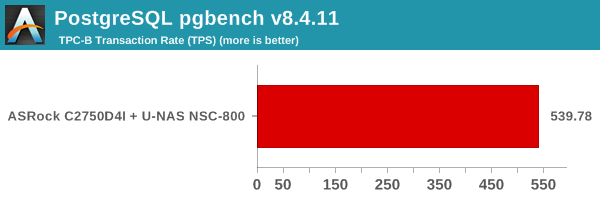
Benchmarks from other systems can be viewed on OpenBenchmark.org
Web Server Benchmarks
The NGINX and Apache benchmarks record the number of static web page requests that can be serviced in a given time interval. It gives an idea of the load that can be handled if a given system were to be configured as a web server. The test load consists of a total of 500K requests (for NGINX) / 1M requests (for Apache) with 100 concurrent ones.
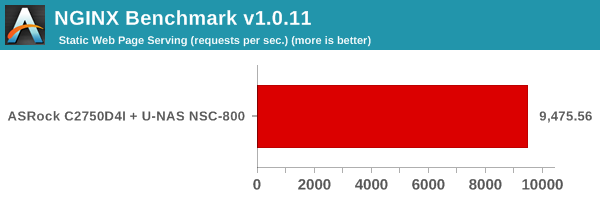
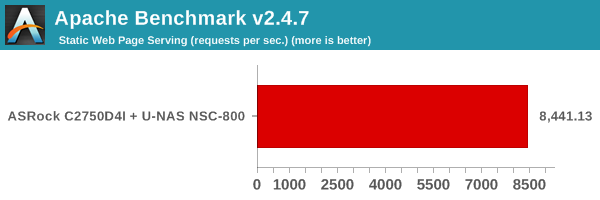
Benchmark numbers for both of these are available on OpenBenchmarking.org (NGINX, Apache).
TCP Loopback
The efficiency of the networking stack in the system (not to be confused with the hardware network adapter itself) can be determined by measures the loopback TCP performance. We record the time taken to transfer 10GB of data via loopback.
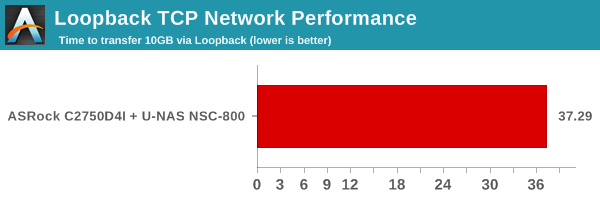
Given that we have the same networking stack for a given OS release across different hardware configurations, the efficiency is going to vary based solely on the CPU capabilities again. Benchmarks from other systems can be viewed on OpenBenchmarking.org.
CacheBench
CacheBench is an artificial benchmark to determine the performance of the cache and DRAM components in a system. It consists of three profiles - reads, writes and read/modify/writes. The bandwidth is recorded for each profile, with bigger numbers indicating better performance.
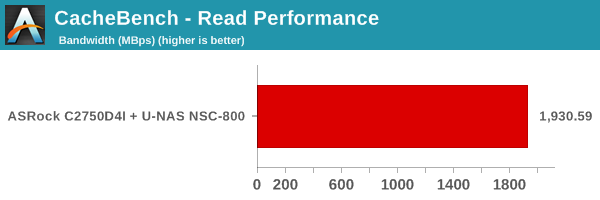
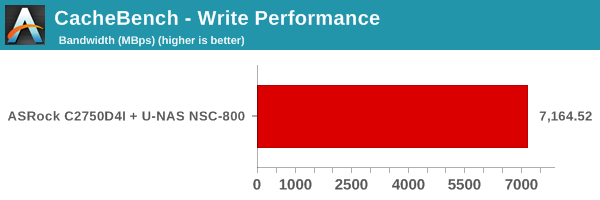
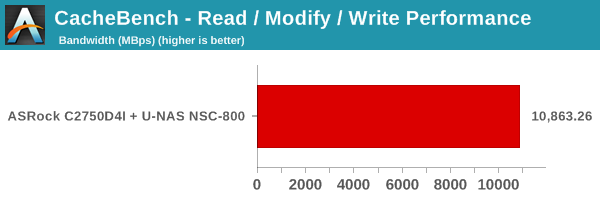
The numbers depend on the internal cache access speeds as well as the speed of the DRAM in the system. Benchmarks from other systems can be viewed on OpenBenchmarking.org
Stream
The system memory is tested out using the stream benchmark. The STREAM benchmark is a simple, synthetic benchmark designed to measure sustainable memory bandwidth (in MB/s) and a corresponding computation rate for four simple vector kernels (Copy, Scale, Add and Triad).
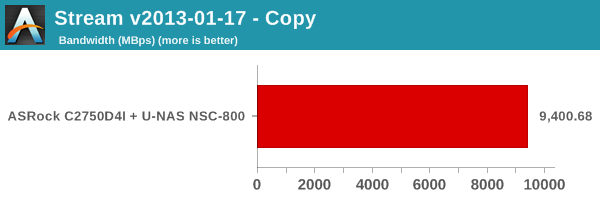
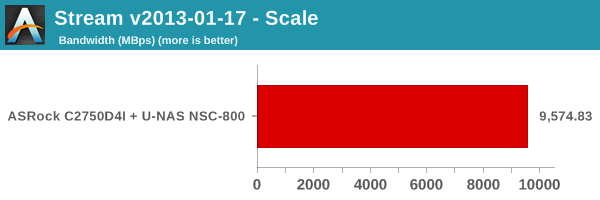
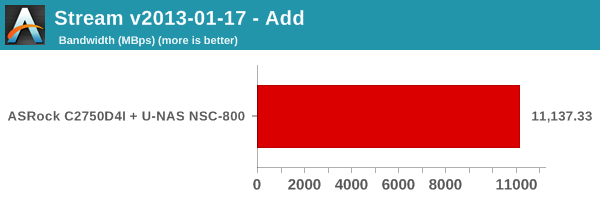
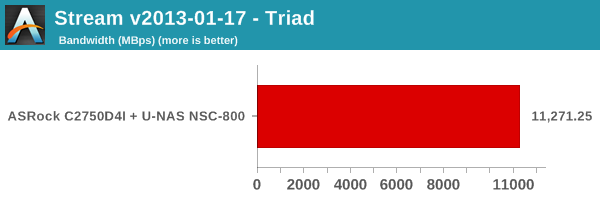
7-Zip Compression
The 7-Zip compression benchmark records the MIPS for the compression mode. This is the same benchmark that we use in the evaluation of mini-PCs, except that this is based on the Linux version. Higher MIPS ratings correspond to better performance, and the numbers are primarily based on the performance of the CPU in the system.
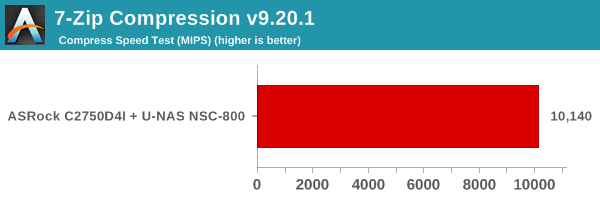
Benchmark numbers for other systems can be viewed on OpenBenchmarking.org
Linux Kernel Compilation
The timed Linux kernel compilation benchmark records the time taken to build the Linux 3.18 kernel. It is a good multi-discipline benchmark, stressing multiple aspects of the system including the DRAM, CPU and, to a certain extent, even the storage.
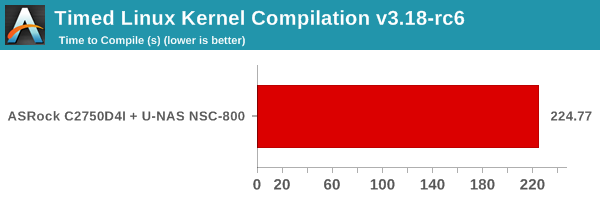
Benchmark numbers for other systems can be viewed on OpenBenchmarking.org
C-Ray
C-Ray is a simple raytracer designed to evaluate the floating point performance of a CPU. This is a multi-threaded test, and the time taken to complete the routine is recorded.
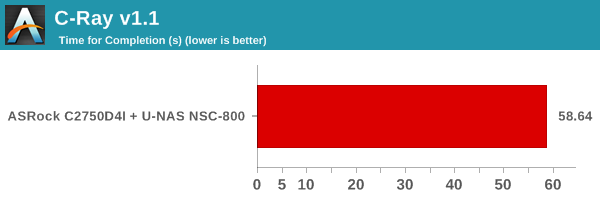
Benchmark numbers for other systems can be viewed on OpenBenchmarking.org










48 Comments
View All Comments
ethebubbeth - Monday, August 10, 2015 - link
Your proposed setup does not support ECC memory, which is essential for any sort of software RAID style configuration. The system in the article does. I would not want to run a NAS without ECC memory unless I were using a hardware RAID card with cache battery backup.brbubba - Monday, August 10, 2015 - link
This system is quite capable of running Plex transcoding, check the cpu benchmark scores. If you want even more power grab a E3C226D2I and throw in an i7.HideOut - Monday, August 10, 2015 - link
All this power an d still USB 2.0 ?DanNeely - Monday, August 10, 2015 - link
It's a 2013 SoC, so no native support on Intel's support. I'm not sure if ASRock deliberately decided not to support it; or just ran out of PCIe lanes. It looks like they should have a few still available but I might be missing something. The SoC has 16 total; 8 go to the PCIe slot, 2 go to sata controllers, 3 to lan controllers, the GPU is a single lane PCIe model. That leaves 2 lanes unaccounted for...DanNeely - Monday, August 10, 2015 - link
Also, it was never intended for use in consumer systems. USB3 primarily matters for backing a NAS to an external HD (or pulling files off of one); Avonton was intended for higher end business class NASes, that whether rackmount or standalone would be primarily accessed over the network.brbubba - Monday, August 10, 2015 - link
Glad to see more mainstream sites posting these types of reviews. I was seriously considering the U-NAS boxes, but they aren't exactly what I call mainstream and I have yet to see any US retailers stocking their products.DanNeely - Monday, August 10, 2015 - link
It appears you can order their cases direct from the manufacturer and pay in USD, so the lack of 3rd party resellers is not a major problem. For my location in the US northeast, they wanted $16.66 to ship the 4bay case. No indication of shipping time was given; so if they don't have a US distribution point they're either shipping slowboat or eating the cost of airmail.Paul357 - Monday, August 10, 2015 - link
A great system for a NAS/Plex Media server. Still though, I'd wait to see what Denverton brings to the table. If it even is announced this year....bobbozzo - Monday, August 10, 2015 - link
Hi,1. would like to have seen more discussion about the power supply quality and other possible choices; will most 1U PSUs work, or is cabling going to be a problem? Would an SFX PSU fit?
2. I didn't notice any mention of noise levels.
3. any idea why the VDI performance was poor?
thanks!
mdw9604 - Tuesday, August 11, 2015 - link
Would like to see an option for redundant power supplies, even it means a bigger chassis.I have a couple of Synology DS1813+ and like them, but my next NAS will need to be beefier and will want some enterprise features, so looking at ZFS, redundant power supplies & possibly an iLO/Drac /Remote Console Card, as it will be located in a data center.
This one doesn't quite make the cut.